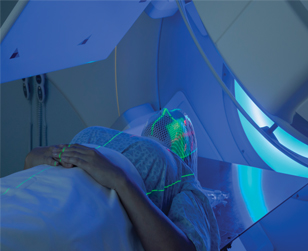MCP: How radiotherapies
vanquish cancer cells
Tumor-shredding therapies aren't created equal. When someone with cancer decides to treat the cellular aberration with radiation therapy, as more than 50 percent of cancer patients now do, their primary options are X-rays or particle beams. Despite being available at only a handful of treatment centers worldwide, particle beams, which use protons or carbon ions, possess a number of benefits over traditional X-rays.

The effects of the beams on the mechanisms that govern signaling within cells remain largely unexplored. A recent paper in the journal sheds some light on this matter.
To better understand the regulatory effects that the particle-based techniques have on the structure and signaling pathways of cancerous cells, researchers at the and applied a combination of high-resolution mass spectrometry and SILAC to irradiated human lung adenocarcinoma cells. SILAC is short for stable isotope labeling by amino acids in cell culture; by incorporating amino acids labeled with heavy isotopes into cell cultures and comparing those cells’ mass spectrometry peaks to those of identical, untreated cell cultures, researchers can examine the effects of an outside agent, such as radiation, on the protein makeup of a culture.
“The research interest is just finding out what radiation is doing to cells, to humans and to tissues,” says senior author at the center’s Functional Proteome Analysis unit. “As a chemist, it was really interesting to work together with the radiation oncologists, because my background is more proteomics and not medicine.”
Whereas X-rays destroy cancer cells by inflicting strand breaks on DNA’s double-helix structure, which can be fixed by DNA repair mechanisms, protons and carbon ions tear the genetic structure apart with complex double-strand breaks, which cannot be repaired. This gives proton and carbon ion beams a larger relative biological effectiveness than X-rays, meaning they kill more cancer cells than X-rays do at the same dose. Additionally, particle beams deposit their energy in a more focused manner than X-rays, damaging to a lesser extent the healthy tissues surrounding tumors.
The researchers separated cultures of the human lung cancer cell line into two groups that were fed amino acids with heavy isotopes or light isotopes and irradiated subgroups of the heavy-labeled cells with x-rays, carbon ions or protons. They then performed a phosphopeptide enrichment to increase the concentration of phosphorylated proteins in each sample before subjecting the cells to mass spectrometry to identify changes that had occurred at the protein structure level and which sites had phosphate molecules added or removed. The addition or removal of these molecules is a key indicator that cells are attempting to mitigate damage and is known in aggregate as the phosphoproteome.
While the researchers observed only limited effects on lung cells at the protein level, they noticed altered phosphorylation regulation on 181 different protein sites, or residues, 151 of which had not been previously been known to be affected by irradiation.
“We’ve looked at differential quantification of the proteins and found that there is little happening as an initial event as a consequence of radiation, whereas the phosphoproteome is massively (dysregulated),” says senior co-author at the center’s Division for Molecular and Translational Radiation Oncology. This information will be helpful for designing future studies that examine the effects of radiotherapy, ionizing radiation and space radiation on cellular signaling processes, he says.
Future work for Schnölzer and Abdollahi will involve looking at the effects of radiation on a longer timescale to understand late effects of irradiation and examining its effects on pathways other than phosphorylation signaling.
Enjoy reading 91Ó°żâToday?
Become a member to receive the print edition four times a year and the digital edition monthly.
Learn moreGet the latest from 91Ó°żâToday
Enter your email address, and we’ll send you a weekly email with recent articles, interviews and more.
Latest in Science
Science highlights or most popular articles

Hope for a cure hangs on research
Amid drastic proposed cuts to biomedical research, rare disease families like Hailey Adkisson’s fight for survival and hope. Without funding, science can’t “catch up” to help the patients who need it most.

Before we’ve lost what we can’t rebuild: Hope for prion disease
Sonia Vallabh and Eric Minikel, a husband-and-wife team racing to cure prion disease, helped develop ION717, an antisense oligonucleotide treatment now in clinical trials. Their mission is personal — and just getting started.

Defeating deletions and duplications
Promising therapeutics for chromosome 15 rare neurodevelopmental disorders, including Angelman syndrome, Dup15q syndrome and Prader–Willi syndrome.

Using 'nature’s mistakes' as a window into Lafora disease
After years of heartbreak, Lafora disease families are fueling glycogen storage research breakthroughs, helping develop therapies that may treat not only Lafora but other related neurological disorders.

Cracking cancer’s code through functional connections
A machine learning–derived protein cofunction network is transforming how scientists understand and uncover relationships between proteins in cancer.

Gaze into the proteomics crystal ball
The 15th International Symposium on Proteomics in the Life Sciences symposium will be held August 17–21 in Cambridge, Massachusetts.

